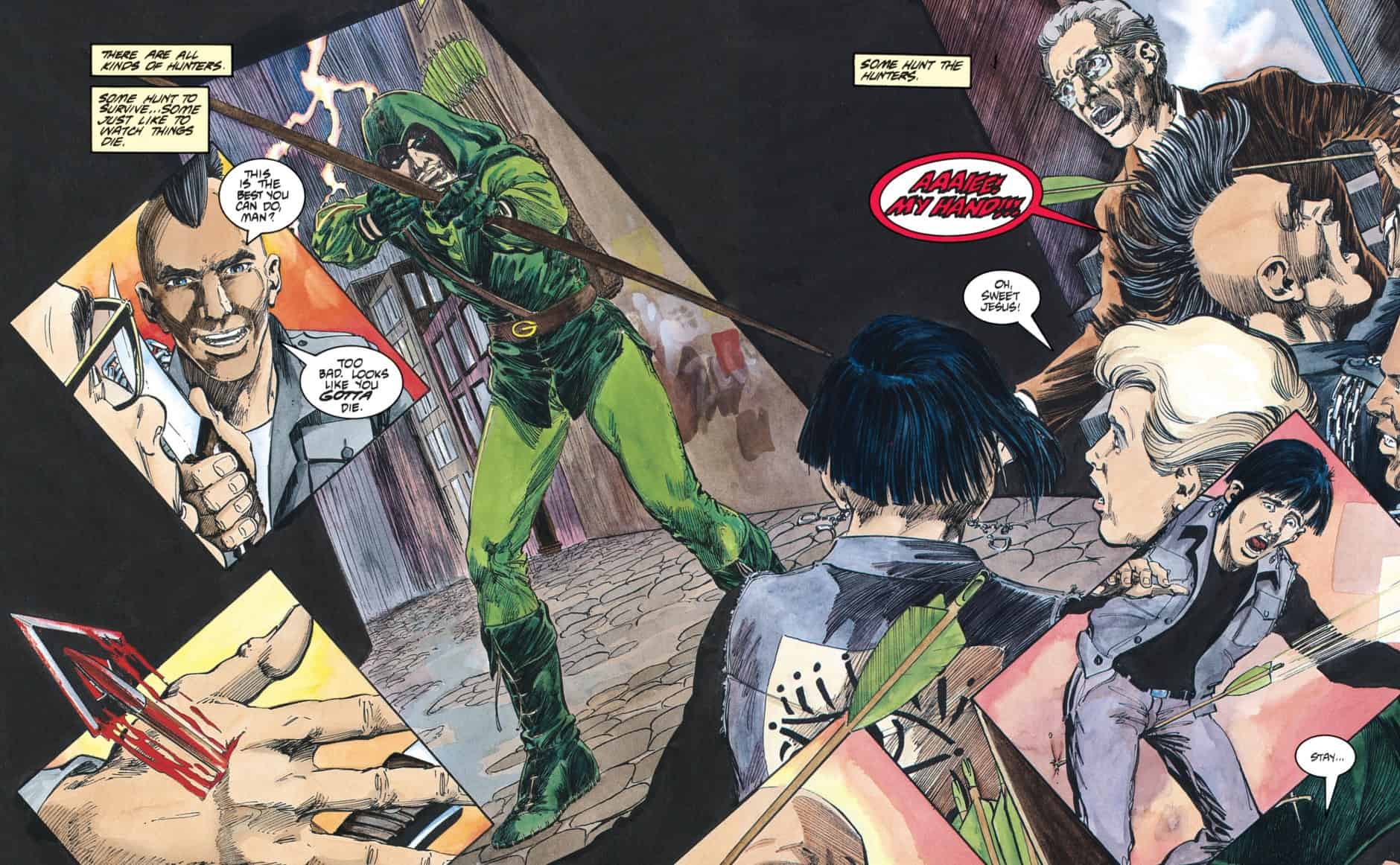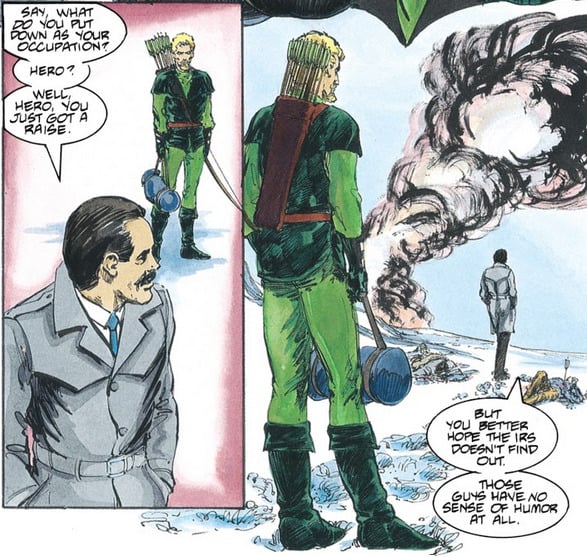Welcome to Throwback Thursday, where Comic Watch celebrates great comics from the past you might have forgotten about!
Green Arrow:
The Longbow Hunters
I love Green Arrow.

And I’m not talking about the Batman-lite version from the Arrowverse and while I have a soft spot for the animated version, he’s still not quite the guy that comic book Oliver Queen is. Oliver Queen is a colossal douchebag whose politics, character and sense of morality, more often than not, would push the people closest to him away and cause unneeded rifts with others that would otherwise be his friends like Barry Allen or Superman. Mike Grell challenged this characterization by deconstructing Oliver Queen as a man and character by uprooting him and giving him a foil that forces him to remember his time on the infamous Starfish Island.
Grell’s writing of Green Arrow chose to focus more on the man vs. the hero by having him question his place in the world and his own legacy as he enters his mid-life crisis. Throughout his history, Ollie has been known to be a womanizer and finally finding love with Dinah Lance and staking out a home with her in Seattle has him feeling like it’s time to start a family with the love of his life. But that is challenged when Dinah states that she doesn’t want to have kids because of the very nature of their lives as superheroes and their likelihood to make them orphans (which would be proven accurate when Ollie dies in Green Arrow #101, 1995). So Ollie has to come to grips with the danger his heroism presents and the fear that he could also lose Dinah as well – and while this doesn’t cause a huge rift between them, this is where some of the first cracks start to form in their relationship which would be expanded on in later books.

At the same time, Green Arrow also has two external threats in the form of the Seattle Slasher and the Robin Hood Killer; both of which offer conflict with his own ideals.
Ollie has always been a character that has taken up the banner for the poor and downtrodden, but at the same time, he’s always had something of a sneering gaze for those he deemed lowlives (see Green Lantern/Green Arrow #85 for how he treated a heroin addicted Roy Harper). So when the Seattle Slasher kills his way across the US, targeting sex workers, it’s up to Green Arrow to find out who this monster is and why he’s killing. One aspect that I do wish this book focused on was Green Arrow coming to terms with helping to save people he previously would have shunned for their lifestyle choices or how, at the time, a lot of the victims may have been forced into the life. Unfortunately, the Slasher is mostly used as a device to show how ineffective Ollie’s more heroic ways were as the Robin Hood Killer then takes center stage by killing the slasher and their own separate quarry.
The Robin Hood Killer, Shado, in her first appearance in the DC Universe, acts as the opposite side of the coin to Oliver Queen. She is a killer, unrepentant in her desire to take revenge on the men who caused her father to commit suicide and this brings her into conflict with The Green Arrow. She outclasses him in every aspect and tries to teach him that her way is the correct path by beating him as an archer and a fighter. Obviously he resists, because he’s supposed to be the hero of the story, but when Black Canary is almost assaulted and killed by the men that Shado’s killing, Oliver breaks his own non-killing code to save her, realizing that Shado was partially right. Seattle doesn’t need another man in spandex – it needs a Hunter to protect it from those that would abuse their power and wealth.

In a sense, Mike Grell realized the Robin Hood allegory that Green Arrow was always based on. Hood killed when he needed to and opposed the rich and powerful. Though Hood himself was loyal to the also not great King Richard, he was often portrayed as being altruistic and loyal to his friends and lovers, in this case Black Canary, his Lady Marian. With this act of killing, Oliver Queen was transformed from just another hero to a grounded, more realistic depiction of what a man who has gone through several years of trauma, heartbreak and loss would be like. Even in later stories, he reflects on the moment and it changes him for the worse, showing that the betrayal of his own personal morals and ethics affected him as it would with any normal person.
Of course, none of the story would matter if not for having amazing art to back it up and thankfully Grell, Lurene Haines and colorist Julia Lacquement do just that.
Mike Grell is one of those once in a generation talents with the ability to write and do the art for a story at the same time and it wouldn’t be difficult to say that his personal touch wasn’t one of the biggest contributing factors to this book’s popularity and impact on the Green Arrow character. Every page and panel is beautifully crafted and laid out to pull the maximum amount of emotion from the characters and their environments. His shot design is fantastic in that he doesn’t use the same angle too many times between panels – he makes use of close ups for emotions, wide angles to show the distance between characters physically and philosophically and full body shots to capture body language and action. He allows the art to focus on characters, backgrounds and minor details that further add to the world itself, though his biggest strengths are his facial expressions and action sequences.

Oliver Queen is a very passionate man and as such, it takes a great artist to project his many moods in ways that don’t seem too reserved or too animated and Grell found the exact sweet spot. When Ollie is angry, we see the frothing rage from his furrowed brow and grit teeth; when he muses about his life, we see his somber nature after his life of pain, there’s a glint in his eyes for the man he used to be and how his trials have shaped him; and when he puts his hood up and dons his guy-liner, his eyes become determined on the mission, focused and piercing. Shado, in stark contrast, never allows her emotions to become clear as that’s the character that she is; calm, collected and focused on the kill. She’s the perfect antithesis to Oliver in that the only thing she wears on her sleeve is a dragon to symbolize the dishonor that her father left their family with – something she has to correct without emotions getting in the way.
And with this being a Green Arrow book, what would it be without archery action? There’s a high intensity to each fight and death that happens in this book, such as when Shado kills someone – there’s a spray of blood and her victims’ faces look like they’ve been hit by a truck, but Green Arrow’s own shots don’t have the same kind of velocity until he uses the full force of his draw strength. It shows their difference of character and later, when they do have their own fight, it feels short and realistic like actual combat. It’s not a grand event as Shado takes him down with one swing of her bow to his gut and much later on, when they work together to stop the drug ring that Canary was investigating, every loosed arrow is a quick and fast kill shot – hitting knee caps, piercing hearts, one guy even gets an arrow through the eye and Grell doesn’t shy away from the gruesomeness of what an arrow can do to the body.

Lurene Haines is the one that should be thanked for helping to bring out the emotion in most of the aforementioned scenes as her watercolors do an amazing job of lifting the pencils. Skin colors and clothes feel rich and textured, full of life even. They look like what the 80s truly were at the time versus the neon coloring that everyone associates with the era, making use mostly earth tones for the city – your browns, dark yellows and greens of course. Other colors include appropriately colored oranges and yellows for fires and gunshots, and blues for police uniforms and some suits.
Though some of my favorite uses of her painted colors have to be in flashback scenes. There, her watercolors take on a more ethereal feel, used in a much more muted or pastel sense. They become lighter and feel more distant on top of the pencils being more shaded than the hatching used in modern scenes. It’s like peering into someone’s mind and looking at a waking dream because that’s the best way I have to describe how the colors make me feel.

By that same token, Julia Lacquement’s colors stand out by being flatter than the water colors, allowing the things colored in that sense to feel discomforting or out of place in some senses. Blood, for instance, is mostly given this kind of coloring and it makes sense because no one is supposed to see it. The color difference amplifies the emotion of the violence to make readers uncomfortable with it. And this same technique is used with Shado’s costume. Her top and mask are completely black like a void, something that doesn’t belong, something that’s meant to make the character feel far more dangerous and unsettling than anything else in the book. It’s a perfect choice and helps her to stand out against the backgrounds and cityscapes.
And finally, Kevin Bruzenak’s lettering is absolutely outstanding. Because of the character driven nature of the book, there is a lot of dialogue and it can be very dense at times, but thankfully Bruzenak makes sure that each word balloon has space to breathe. He doesn’t obscure the art and makes use of the empty space in some of the panels to maximize real estate, the same can be said for the various and easily identifiable thought boxes, colored to indicate whose thoughts we’re following.

In my opinion, Longbow Hunters is the story that did for Green Arrow what Born Again did for Daredevil. It’s the story that changed the status quo of a character that was pretty much floundering before a great team took up the challenge of breathing new life into him. It garnered so much praise that Grell would write the first Green Arrow solo series afterwards and cemented him as a strong force for good in the DC Universe. Truly, it should be held in the same breath as many other character defining books as the pinnacle of what comic books can accomplish as an art form.
Mike Grell, Lurene Haines, Julia Lacquement and Kevin Bruzenak created something amazing with this book and more people should go out of their way to find and enjoy it like I do.





